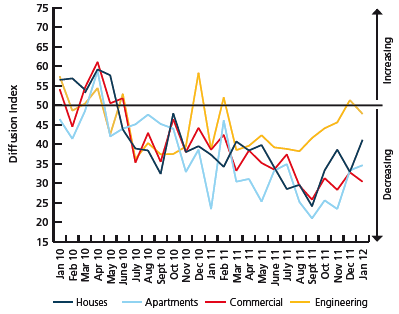
The AIG PCI is out this morning and shows more weakness head for dwelling construction:
The national construction industry declined again in January amid further falls in activity and new orders.
■ The Australian Industry Group Performance of Construction Index (Australian PCI®) in conjunction with the Housing Industry Association decreased by 1.2 points to 39.8 in January. This reading remained below the critical 50 point level separating expansion from contraction for a 20th consecutive month.
■ Commercial and apartment building activity remained particularly subdued. However, the decline in house building activity eased markedly. Engineering construction activity turned negative, although it remained the best performing sector.
■ Most businesses linked the weakness in activity levels to tight credit conditions, a lack of new tender opportunities and strong competition for existing work. On a positive note, various house building businesses indicated that the successive interest rate cuts in November and December last year had helped to support an improvement in both customer enquiries and activity.
■ For the industry as a whole, activity and new orders declined at a steeper pace during the month. Despite employment continuing to contract, the rate of decline moderated.
Like the AIG PSI, I’m suspicious of the AIG PCI, Performance of Construction Index. The index is dominated by home building yet claims to be representative of the “national construction industry”.
A look at the index sub-components makes the point:

I’m not for a moment suggesting that home building isn’t weak, it is, everywhere except Melbourne. But any assessment of the national construction industry must surely take account of the historic engineering construction associated with the mining boom and, judging by the subdued engineering component, this index clearly does not.
Either that, or mining construction strength is being overwhelmed by weakness is traditional construction. For which there is no evidence in broader economic indexes such as GDP components.
As such, the index smacks of partial analysis, the promotional use of select economic data.
Full report below.

